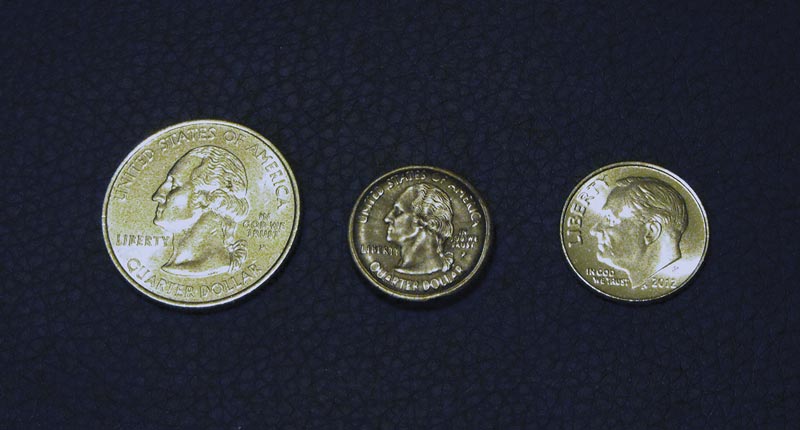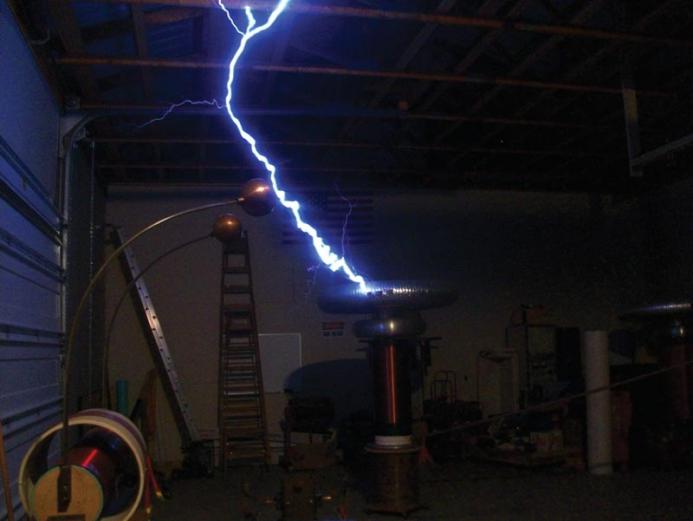The Teslathon
Spring
2013
Interactions - SPS Chapters in Action
The Teslathon
Sparks Fly at Tesla Coil Lab
By:Jay Howson at the Rochester Institute of Technology

On October 11 the Rochester Institute of Technology SPS chapter rolled down a nondescript gravel road toward a large garage. We had arrived at the “lab” of Ed Wingate, who constructed his first Tesla coil when he was 12 and has been playing with high voltage for nearly 50 years. Every year for the past two decades, he has invited guests over for an event he calls the Teslathon.
Made of steel sheets welded together and grounded, the building serves as a massive Faraday cage for the high-voltage goodies housed within. Walking inside, we saw tall coils of red magnet wire, stacks of Maxwell pulse capacitors, corona rings, and more than five large distribution transformers.
Starting off small, Wingate first demonstrated a tabletop device, a vacuum tube Tesla coil that filled the room with a low 60-hertz hum. Sparks—about 2 feet in length—sprouted from the top. Radiant fields lit fluorescent light bulbs and neon tubes several feet away.
The main event was the magnifier Tesla coil, built of three coils tuned to around 62 kHz. Wingate rolled one of the coils, 8 feet tall, to the center of the room. It burst to life with a sound so loud that ear protection was mandatory. The input power topped off at 13 kW, and the peak currents were in excess of 2 kA!
Relatively small sparks, 3 to 5 feet in length, were produced at first. Then 15- to 20-foot arcs were hitting the floor, ceiling, and garage door. Wingate kept the sparks in a localized area using a form of field control called a breakout point; think of a lightning rod, but in reverse.
Some of us stood inside the “Cage of Death,” an enclosure of chicken wire. We watched man-made lightning strike inches from our noses. Up close we could see the individual paths produced by each pulse of the spark gap. Each pulse separated from the one before it as the heat of the plasma caused the ionized air to rise.
Then our host, the master tinkerer, asked rhetorically, “Is it time to shrink some quarters?” He rolled out a cart with two massive series capacitors charged to 8 kJ. When the capacitors discharged, a current topping out at about 10 kA pulsed into a small coil (less than 10 turns of number 10 magnet wire) around a quarter inside small steel vault bolted shut. After this release of energy, there was no coil left—just a million tiny coil pieces. The quarter shrank—crushed by a powerful magnetic field—and was smaller than a dime!
For his last trick Wingate connected a length of hair-thin tungsten wire across the capacitors. He gave the device some extra juice, just for us. We saw a flash and heard a sound like a gunshot. There were no wires or wire bits left this time. It was an incredible experience. //
Lightning Master
From an interview with Ed Wingate by Kayla Emerson at the Rochester Institute of Technology
I hated school! The teachers used to let me have the run of the back room where all the physics apparatus were. I kind of had special privileges, I was one of the few students they let back there. Other than that, I really didn’t like school that much.
I have been building Tesla coils since I was in eighth grade, which was around 1960. I have always been interested in science and mechanics and what makes things work.
Then I got out of school, went into other things. Got a
job in my hometown, then finally moved to Rochester, got a job at Kodak. Quite a few years went by when I did nothing with coils. Then the bug bit me again around 1985 to 1990, when my wife and I moved to the house out here [in Brockport, NY] where I had room to do the Tesla coil stuff.
I started in the basement here in the house. The insurance company probably would not have appreciated what was happening in the basement. Then I decided, when the sparks got to seven feet and were hitting everything in the basement, it was time to build a lab out back. //
FURTHER READING:
Learn more about RIT's SPS chapter: https://campusgroups.rit.edu/sps/about/.

